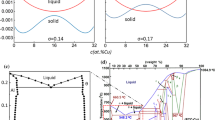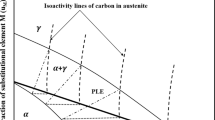Abstract
Tight-binding quantum chemical molecular dynamics method has been applied in order to study the Σ3 (111), Σ5 (100) and random grain boundaries oxidation initiation mechanism of fcc Fe–Cr binary alloy in a boiling water reactor environment. The metal–water interaction at high temperatures causes diffusion of environmental species and segregation of metallic atoms. Water molecules favorably permeate through the random grain boundary (GB) to find the space generated by atomic rearrangement, although it is difficult to diffuse in the Σ3 (111) and Σ5 (100) grain boundaries. Moreover, applied strain creates extra spaces in the lattice that can facilitate the absorption of environmental species. The highly positively charged chromium and the negatively charged oxygen atoms or OH remain along the GB by forming bonds. The GB atoms selectively lose their valence electrons when dissociated atoms adsorb, indicating that the oxidation process is a possible mechanism of intergranular cracking initiation.





Similar content being viewed by others
References
S. Wang, T. Shoji and N. Kawaguchi, Corrosion 61, 137 (2005).
T. Shoji, S. Suzuki and R. G. Ballinger, Proceedings of the 7th International Symposium on Environmental Degradation of Materials in Nuclear Power Systems-Water Reactors, (Breckenridge, Colorado, 1995), p. 881.
S. M. Bruemmer, B. W. Arey and L. A. Charlot, Corrosion 48, 42 (1992).
L. E. Thomas and S. M. Bruemmer, Corrosion 56, 572 (2000).
R. N. Parkins, Corrosion 52, 363 (1996).
R. W. Staehle, in The Theory of Stress Corrosion Cracking in Alloys, ed. J. C. Scully (NATO, Brussels, 1971), p. 86.
W. W. Smeltzer, Materials Science Forum 29, 151 (1989).
G. P. Airey, Corrosion 35, 129 (1979).
E. M. Lechochey, A. M. Brennenstuhl and I. Thompson, Corrosion Science 46, 2383 (2004).
P. Lin, G. Palumbo, U. Erb and K. T. Aust, Scripta Materialia 33, 1387 (1995).
V. Y. Gertsman, K. Tangri and R. Z. Valiev, Acta Materialia 42, 1785 (1994).
V. Y. Gertsman and S. M. Brummer, Acta Materialia 49, 1589 (2001).
D. C. Crawford and G. S. Was, Metallurgical Transaction 23A, 1195 (1992).
U. Krupp, V. B. Trindade, P. Schmidt, H.-J. Christ, U. Buschmann and W. Wiechert, Defect and Diffusion Forum 237–240, 946 (2005).
J. P. Buban, K. Matsunaga, J. Chen, N. Shibata, W. Y. Ching, T. Yamamoto and Y. Ikuhara, Science 311, 212 (2006).
M. Yamaguchi, M. Shiga and H. Kaburaki, Science 307, 393 (2005).
R. Wu, A. J. Freeman and G. B. Olson, Science 265, 376 (1994).
Z. Z. Chen and C. Y. Wang, Physical Review B 72, 104101 (2005).
R. Yang, Y. M. Wang, R. Z. Huang, H. Q. Ye and C. Y. Wang, Physical Review B 65, 094112 (2002).
W. T. Geng, A. J. Freeman, R. Wu, C. B. Geller and J. E. Raynolds, Physical Review B 60, 7149 (1999).
J. X. Shang, X. D. Zhao, F. H. Wang, C. Y. Wang and H. B. Xu, Computational Materials Science 38, 217 (2006).
D. Farkas, S. V. Petegem, P. M. Derlet and H. V. Swygenhoven, Acta Materialia 53, 3115 (2005).
N. K. Das, Fundamental Mechanistic Study of Stress Corrosion Cracking: Quantum Chemical Molecular Dynamics Approach, Ph.D. Dissertation (Graduate School of Engineering, Tohoku University, Japan, 2008).
N. K. Das, K. Suzuki, Y. Takeda, K. Ogawa and T. Shoji, Corrosion Science 50, 1701 (2008).
N. K. Das, K. Suzuki, K. Ogawa and T. Shoji, Corrosion Science 51, 908 (2009).
N. K. Das, T. Shoji and Y. Takeda, Corrosion Science 52, 2349 (2010).
http://accelrys.com/products/materials-studio/. Accessed Oct 2007.
H. Ogawa, Materials Transaction 47, 2706 (2006).
N. K. Das and T. Shoji, International Journal of Hydrogen Energy 38, 1644 (2013).
F. Ahmed, M. K. Alam, A. Suzuki, M. Koyama, H. Tsuboi, N. Hatakeyama, A. Endou, H. Takaba, C. A. D. Carpio, M. Kubo and A. Miyamoto, Journal of Physical Chemistry C 113, 15676 (2009).
R. W. Balluffi, American Society of Metals, (Metal Park, Ohio, 1980).
P. J. Gellings and M. A. D. Jongh, Corrosion Science 7, 413 (1967).
K. P. R. Reddy and A. R. Cooper, American Ceramic Society Bulletin 55, 402 (1976).
A. Ul-Hamid, Oxidation of Metals 57, 217 (2002).
W. M. Yin, S. H. Whang and R. A. Mirshams, Acta Materialia 53, 383 (2005).
W. M. Yin and S. H. Whang, Scripta Materialia 44, 569 (2001).
N. Wang, Z. Wang, K. T. Aust and U. Erb, Materials Science and Engineering A 237, 150 (1997).
V. B. Trindade, U. Krupp, B. Z. Hanjari, S. Yang and H.-J. Christ, Materials Research Bulletin 8, 317 (2005).
P. Fernández, M. García-Mazaría, A. M. Lancha and J. Lapena, Journal of Nuclear Materials 329–333, 273 (2004).
J. Lapena, M. García-Mazaría, P. Fernández and A. M. Lancha, Journal of Nuclear Materials 283–287, 662 (2000).
A. U. Seybolt, Journal of Electrochemical Society 107, 147 (1960).
D. Caplan and M. Cohen, Journal of Electrochemical Society 112, (5), 471 (1965).
D. P. Whittle and G. C. Wood, Journal of Electrochemical Society 115, (2), 133 (1968).
D. Mortimer and M. L. Post, Corrosion Science 8, 499 (1968).
H. Asteman, J.-E. Svensson and L.-G. Johansson, Journal of Electrochemical Society 151, B141 (2004).
H. Asteman, J.-E. Svensson, M. Norell and L.-G. Johansson, Oxidation of Metals 54, 11 (2000).
H. Asteman, J.-E. Svensson, M. Norell and L.-G. Johansson, Oxidation of Metals 52, 95 (1999).
H. Asteman, J.-E. Svensson and L.-G. Johansson, Corrosion Science 44, 2635 (2002).
J. L. Smialek, Metallurgical Transactions 9A, 309 (1978).
J. Stringer, I. M. Allam and D. P. Whittle, Thin Solid Films 45, 377 (1977).
R. Molins, G. Hochestetter, J. C. Chassaigne and E. Andrieu, Acta Materialia 45, 663 (1997).
J. Tong, S. Dalby and J. Byrne, Journal of Materials Science 40, 1237 (2005).
L. V. Saraf, A. S. Lea, C. M. Wang, A. Dohnalkova and B. W. Arey, Microscopy and Microanalysis 16, 690 (2010).
E. L. Hall and C. L. Briant, Metallurgical Transaction A 15A, 793 (1984).
R. L. Tapping, R. D. Davidson, E. McAlpine and D. H. Lister, Corrosion Science 26, 563 (1986).
A. Szabo and N. S. Ostlund, Modern Quantum Chemistry, (McGraw-Hill, New York, 1989).
K. B. Wiberg and P. R. Rablen, Journal of Computational Chemistry 14, 1504 (1993).
N. K. Das and T. Shoji, Applied Surface Science 258, 442 (2011).
S. Veliah, K. Xiang, R. Pandey, J. M. Recio and J. M. Newsam, Journal Physical Chemistry B 102, 1126 (1998).
N. K. Das, I. Tirtom and T. Shoji, Materials Chemistry and Physics 122, 336 (2010).
Acknowledgments
Part of this work was supported by the PEACE-E Phase II program jointly supported EDF, EPRI, SSM, TEPCO, KEPCO, Tohoku EPCO, Chubu EPCO, JAPCO, HITACHI Ltd., MHI, TOSHIBA Co., and IHI.
Author information
Authors and Affiliations
Corresponding author
Rights and permissions
About this article
Cite this article
Das, N.K., Shoji, T. Early Stage Oxidation Initiation at Different Grain Boundaries of fcc Fe–Cr Binary Alloy: A Computational Chemistry Study. Oxid Met 79, 429–441 (2013). https://doi.org/10.1007/s11085-013-9366-2
Received:
Revised:
Published:
Issue Date:
DOI: https://doi.org/10.1007/s11085-013-9366-2




